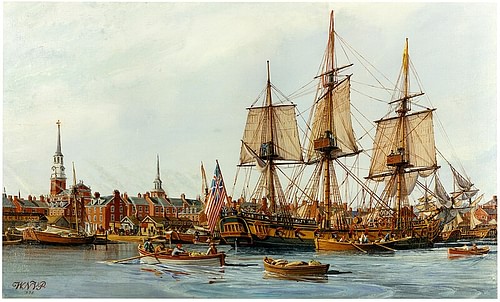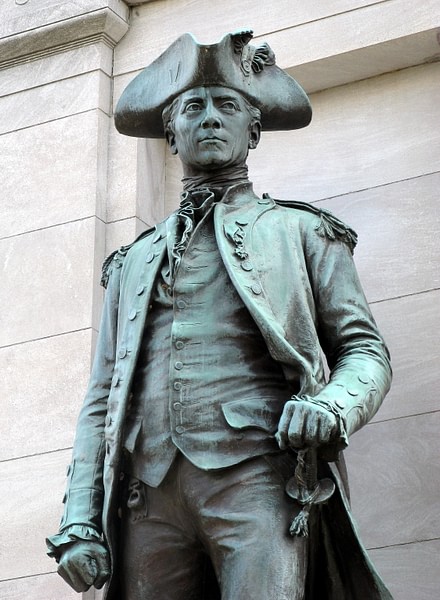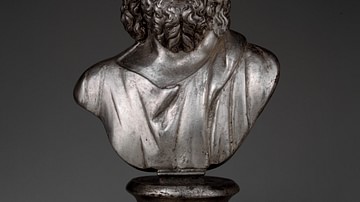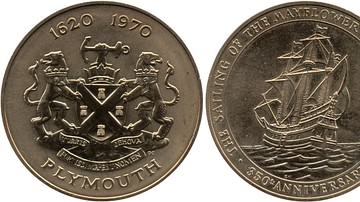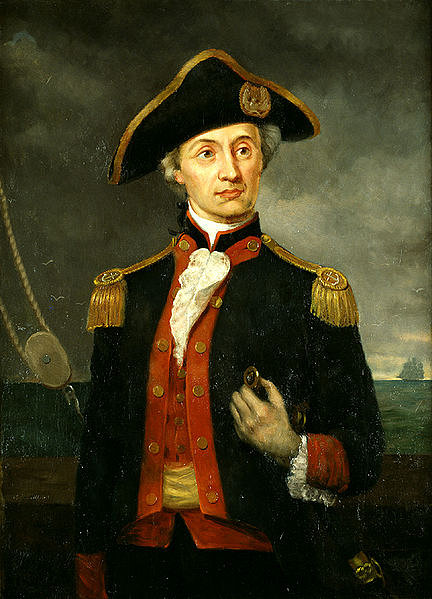
John Paul Jones (1747-1792) was a Scottish-born sailor who served in the Continental Navy during the American Revolutionary War (1775-1783). His raid on the English port town of Whitehaven in 1778 and his victory over the HMS Serapis the following year turned him into a war hero and led many to consider him the 'Father of the American Navy'.
Jones began his maritime career at the age of 13, serving aboard various merchant vessels and slave ships. After killing a mutinous sailor in the West Indies, he fled to the British colony of Virginia and joined the Continental Navy when the American Revolution broke out in 1775. He was given command of the USS Ranger, which he used to attack British commercial shipping in the Irish and North Seas. He raided Whitehaven, plotted to kidnap the Earl of Selkirk, and commanded the USS Bonhomme Richard in its grueling, 3-hour naval duel with HMS Serapis. These actions cemented Jones' reputation as one of the best naval commanders in US history. After the war, the Continental Navy was disbanded, leading Jones without prospects. He therefore entered the service of the Russian Empire in 1787 but left in disgrace two years later, after sexual assault allegations against him sparked an international scandal. He died in Paris on 18 July 1792 at the age of 45.
Early Life
On 6 July 1747, John Paul was born at the estate of Arbigland in the county of Kirkcudbrightshire, Scotland – he would not add 'Jones' to his name until he came to America. His father was the head gardener at Arbigland and had seven children, five of whom would survive to adulthood. Though John Paul attended the nearby Kirkbean School, his true education occurred at Carsethorn, the local port. He would spend much of his free time there, breathing in the briny sea air, marveling at the comings and goings of ships, and talking with sailors, learning everything he could about life at sea. Paul could not long resist the call of the sea and, at the age of 13, he obtained an apprenticeship with John Younger, a Scottish merchant and shipowner operating out of the English port town of Whitehaven.
It was not long before John Paul embarked on his first voyage, sailing out of Whitehaven aboard one of Younger's vessels, the Friendship, as a ship's boy. The voyage took Paul across the Americas, stopping first at Barbados before sailing up to the British colony of Virginia. Here, Paul briefly reunited with his older brother, Thomas, who had previously emigrated to Fredericksburg, Virginia. In 1764, upon returning to Whitehaven, Paul was released from his apprenticeship early, because Younger's business had gone bankrupt. He found work aboard a slave ship and spent the next three years transporting human cargo from Guinea to Jamaica. In 1766, the 19-year-old Paul became first mate of the slave ship Two Friends, a lucrative position. However, he gradually grew disillusioned with the slave trade and became disgusted at his own role in perpetuating it. In 1768, he abandoned the Two Friends while it was docked in Kingston, Jamaica, and booked passage on a ship bound for Scotland.
Not long into the voyage, both the ship's captain and first mate died of yellow fever. Since there was no one else on board who knew how to navigate a ship, Paul took charge and guided the vessel safely to Scotland. The ship's grateful owners rewarded Paul with ten percent of the vessel's cargo. Impressed with his nautical skills, they also offered him the captaincy of a merchant brig named John. Paul accepted and captained two voyages to the West Indies. It was during his second voyage, in 1770, that Paul had the ship's carpenter flogged with cat-o'-nine-tails as punishment for neglect of duty. The carpenter died at sea several weeks later. When the John returned to port, Paul was arrested and imprisoned at Kirkcudbright Tolbooth, charged by the dead man's father of having caused his death. Paul maintained that the carpenter's death had been unrelated to the flogging, that it had instead been caused by yellow fever. After producing several witnesses to substantiate this claim, Paul was acquitted, although the incident left a dark stain on his reputation.
In 1772, Paul once again sailed into the West Indies, this time captaining a merchant vessel called Betsy. Toward the end of the voyage, in 1773, the Betsy arrived at Tobago, where several sailors decided to stage a mutiny. Paul responded to the mutineers' demands by running the ringleader through with his sword, killing him. Although Paul would always claim that he had acted out of self-defense, he knew that the public opinion in Tobago would be against him, since the man he had killed had been a local. To evade a trial, he fled to mainland North America, where he added 'Jones' to his name to help conceal his identity. After the death of his brother William, he went to Fredericksburg, Virginia, to settle his affairs and decided to live there himself.
In the Continental Navy
By the time the first shots of the American Revolutionary War were fired at the Battles of Lexington and Concord (19 April 1775), Jones had become sympathetic to the Patriot cause; despite having lived in Virginia for less than two years, the Scottish-born sailor was now an outspoken proponent of American liberties. In early December 1775, Jones arrived in Philadelphia to offer his services to the newly established Continental Navy. Experienced naval officers were in high demand, and Jones was commissioned as a first lieutenant aboard a 24-gun frigate, the USS Alfred. As the Alfred prepared to sail out of the Delaware River in February 1776, Lt. Jones hoisted the Grand Union Flag; it was the first time that the flag, the first to be used by the united Thirteen Colonies, had been raised.
In March 1776, the Alfred participated in a raid against the British port of Nassau in the Bahamas and skirmished with a British packet ship during its return voyage a month later. Jones performed well in these actions and, in May, was given command of the sloop Providence as well as the rank of captain. An ambitious man, Jones was determined to prove himself and pushed his crew hard. In the summer of 1776, the Providence crisscrossed the Atlantic coast, traveling between Bermuda and Nova Scotia; during this period, Jones twice outran larger British frigates, captured eight prizes, and burned and sank eight more. Jones' temperament made him unpopular with his fellow captains, and he often quarreled with his superior officer, Commodore Esek Hopkins. Nevertheless, Jones' success quickly drew the attention of Congress, and, on 14 June 1777, he was appointed to command the newly built sloop-of-war USS Ranger.
Congress instructed Jones to sail to Europe, where he was ordered to pick up another ship, the Indien, a frigate that was being constructed in Amsterdam for the United States. When Jones arrived in December, he learned that Britain had pressured the Dutch to sell the Indien to France instead, a nation that was, at the time, still neutral in the conflict. Frustrated, Jones spent the winter in Paris, where he struck up a close friendship with Benjamin Franklin, one of the American commissioners to France. Largely through Franklin's efforts, France signed a Treaty of Alliance with the United States in February 1778 and entered the war shortly thereafter. Eight days after the alliance was signed, Jones' ship, the Ranger, became the first American naval vessel to be formally saluted by a foreign nation, when a French warship fired a nine-gun salute.
Raids Against the British
On 10 April 1778, Jones sailed the Ranger out of the French port of Brest. His ship was crewed by 140 men and was armed with 18 six-pounder cannons and 6 swivel guns. After conducting minor raids on British commercial shipping in the Irish Sea, Jones sought a bigger prize and convinced his crew to join him in an assault on Whitehaven, the port where he had begun his nautical career. Discreetly anchoring the Ranger offshore, Jones and 30 crewmen quietly rowed into Whitehaven in two small boats at 3 a.m. on 23 April. They successfully spiked the town's cannons before attempting to set fire to the merchant vessels in the harbor. Only three ships had caught fire before someone noticed what was happening and raised the alarm. Jones and his men escaped as a crowd of townspeople put out the flames. The raid on Whitehaven, while minor, is nevertheless noteworthy for being "the only American operation of the war on English soil" (quoted in Boatner, 1199).
Later that same day, Jones sailed the Ranger across Solway Firth to St. Mary's Isle, where he plotted to kidnap the Earl of Selkirk and hold him for ransom. The earl was not at home, however, and Jones' landing party returned to the ship empty-handed except for a silver plate bearing the family's emblem, which was returned to Selkirk after the war. As it recrossed the Irish Sea, the Ranger encountered a British sloop, Drake, which was anchored off Carrickfergus, Ireland. The two vessels, roughly of equal firepower, engaged in a two-hour skirmish on the afternoon of 24 April, which ended when the British captain was killed. Jones sent a party under his second-in-command, Lieutenant Thomas Simpson, to take possession of the Drake and bring it back to Brest. Jones remained in the Irish Sea aboard the Ranger, capturing several more prizes before returning to Brest on 8 May. His short voyage, during which he had raided English soil, threatened an earl, and captured a British sloop, had caused much alarm along the British coast, and launched Captain Jones into international fame.
Bonhomme Richard
Upon his return to Paris, Jones found he had become a celebrity. France had just officially declared war on Britain, and his exploits turned him into the toast of French high society. In 1779, he was given command of a larger ship, the 42-gun Duc de Duras, which had recently been converted from a merchant vessel into a warship. Jones renamed the ship USS Bonhomme Richard in honor of his friend, Benjamin Franklin (this was a reference to Franklin's Poor Richard's Almanac, which had been published in France as Les Maximes du Bonhomme Richard). With the Bonhomme Richard as his flagship, Jones was also given authority over a makeshift fleet that included two frigates, a corvette, a cutter, and two privateering vessels. On 14 August 1779, Jones' squadron set out for the Irish coast, intending to cause as much chaos as possible around the British Isles.
The expedition got off to a rough start. Four days into the voyage, the two privateers abandoned the fleet after a dispute with Jones over loot. A short while later, Jones lost another vessel, the cutter Le Cerf, when it became separated from the fleet and opted to return to France. Furthermore, Jones faced insubordination from the French naval officers captaining the smaller vessels, who did not like taking orders from a Scottish-born American like Jones and were not shy about letting him know it. The most outspoken of these officers was Pierre Landais, captain of the frigate USS Alliance, who flatly told Jones that he intended to operate his vessel as he saw fit. Despite these tensions, the fleet took several prizes as it sailed around northern Scotland, eventually charting a course back south. On the afternoon of 23 September, Jones spotted a convoy of 40 British merchant ships being escorted by two warships, HMS Serapis and Countess of Scarborough.
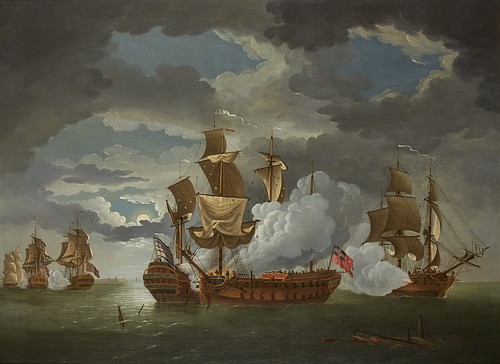
Jones decided to attack and sailed Bonhomme Richard out, signaling for his other ships to form a single-file line of battle. The French officers, believing they knew better than Jones, refused to comply; Captain Landais sailed the Alliance out to deal with the smaller enemy ship, Countess of Scarborough, while the other two allied vessels hung back, letting Bonhomme Richard challenge the 50-gun Serapis alone. The Serapis, meanwhile, had sailed out to meet Bonhomme Richard head-on, to give the merchant vessels a chance to escape. What followed was a brutal, three-and-a-half-hour duel, often considered the most famous naval engagement of the war. Bonhomme Richard and Serapis each fired devastating broadsides at point-blank range, as the sailors took shots at one another with muskets and blunderbusses. The two ships soon became locked together when the Serapis' jib-boom got caught in the Bonhomme Richard's mizzen mast. Although Serapis outmatched Bonhomme Richard in speed and firepower, Jones refused to give up; when called upon by the British captain to surrender, Jones apparently replied: "I have not yet begun to fight!" (Middlekauff, 542).
Before long, both vessels were on fire and sinking. During the struggle, Captain Landais sailed his frigate past the interlocked ships, firing a total of three broadsides into the fray. The broadsides caused significant damage to both Serapis and Bonhomme Richard, with one of the broadsides mostly hitting the Richard's stern; some scholars contend that Landais' friendly fire was intentional so that he could sink Jones' ship and claim credit for the victory himself. But despite these difficulties, Jones eventually proved victorious; at around 10:30 p.m., the captain of the Serapis struck his colors and surrendered his sword. Jones had won the Battle of Flamborough Head, as the engagement was called, at a terrible price; 170 of his men had been killed or wounded, and Bonhomme Richard was too damaged to be repaired and sank two days later. Jones transferred the crew to the captured Serapis and sailed for the safety of Holland, arriving on 3 October.
End of the War & Russian Service
Shortly after Jones' arrival in Holland, the British government demanded that the Dutch Republic hand him over and return the captured British vessels. In their eyes, Jones was nothing more than a pirate, a "rebel subject and a criminal of the state" (Boatner, 566). This put the Dutch Republic in a precarious situation; by refusing to arrest Jones as a pirate, the Dutch would be implicitly recognizing the independence of the United States, which would therefore violate their neutrality. Jones saved them from this predicament by gifting all his vessels except the Alliance to the French government so that they could no longer be considered pirate vessels. Removing the unstable Landais from command, Jones then sailed the Alliance back to France, where he was given a hero's welcome and honored with the title 'chevalier' by King Louis XVI of France (r. 1774-1792).
In February 1781, Jones returned to the United States after a three-year absence. During the waning years of the Revolutionary War, he was appointed to the command of the USS America, the largest ship in the Continental Navy, but he never actually assumed command, as Congress decided to gift the vessel to France instead. In 1783, the United States won the war, and the Continental Navy was disbanded, leaving Jones without prospects in his adoptive country. He went to France to collect the prize money owed to him from his expeditions and stayed there until the summer of 1787, when he returned to the United States for the last time to accept a gold medal from Congress, the only such medal issued to an officer of the Continental Navy.
By now, Jones was once again without money, leading him to accept an offer to enter the service of Empress Catherine the Great of Russia (r. 1762-1796). The Russians were, at the time, involved in a war with the Ottoman Empire, and Jones was commissioned as a rear admiral in the Russian Navy aboard the 24-gun ship Vladimir. He took part in several naval actions in the Black Sea and was awarded the Order of Saint Anna on 8 June 1788. Jones, however, was treated with disdain by many of the other officers in the service of Russia, who felt threatened by him; these included former British officers, who naturally had reason to hate Jones, whom they still regarded as a pirate. Partly due to their intrigues, the empress' favorite, Prince Grigory Potemkin, ultimately turned against Jones as well.
Allegations & Later Life
In April 1789, Jones was accused of raping Katerina Stepanova, a ten-year-old girl who testified that Jones had physically and sexually assaulted her when she had gone to his apartment to sell him butter. The girl was examined by both a regimental surgeon and a midwife, who reported that Stepanova's injuries were consistent with her claims. Jones denied the allegations, claiming that they were nothing but an attempt to ruin his reputation and remove him from power. The officers and Russian nobility, who had already been looking for an excuse to get rid of Jones, seized the opportunity to publicize the incident, turning it into an international scandal. Empress Catherine sided with Stepanova and ultimately banished Jones from the Russian court. Still protesting his innocence, Jones returned to Paris in 1790.
Jones spent his last two years in Paris. He no longer had friends there, and the allegations against him had alienated him from the community. In June 1792, the United States appointed him as an ambassador to negotiate with the dey of Algiers for the release of American captives. But before Jones could take up this post, he was found dead in his Paris apartment on 18 July 1792, aged 45. He was buried in Paris, and his remains were not returned to the United States until 1913, when they were interred in the Naval Academy Chapel in Annapolis, Maryland.

